2012 VOLKSWAGEN SCIROCCO brake
[x] Cancel search: brakePage 111 of 138
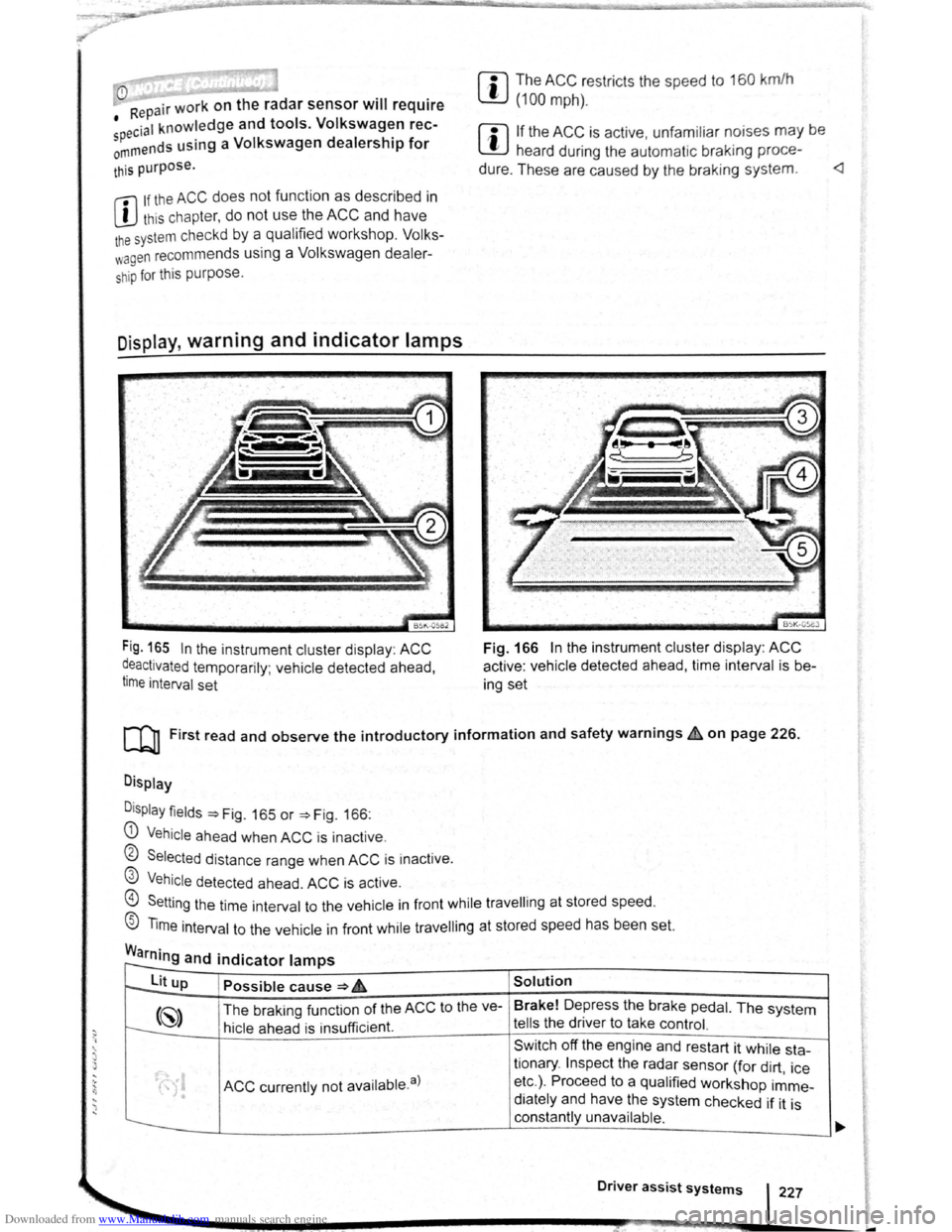
Downloaded from www.Manualslib.com manuals search engine .... ... ' 1)
' ) ....
m The ACC restricts the speed to 160 km/h
W (100 mph). 0
Repair wor k on the radar sensor will require
• ecial knowled ge and tools. Volkswagen rec
~~mends using a Volkswagen dealership for
m If the ACC is active, unfamiliar noises may be
W heard during the automatic braking proce-
this purpose.
dure. Th ese are caused by the braking system.
W this chapte r, do not use the ACC and have
the system checkd by a qualified workshop . V olks
wagen recommends using a Vol kswagen dealer
ship for this purpose .
Display, warning and indicator lamps
Fig. 165 In the instrument cluster disp lay : ACC
~eactivated temporarily ; vehicle detected ahead,
t1me interval set
BSK-05eJ
Fig. 166 In the instrument cluster display : ACC
active : vehicle detected ahead, time interval is b e
ing set
[Q] First read and observe the introductory information and safety warnings~ on page 226.
Display
D
isplay fields ~Fig. 165 or ~Fig. 166:
G) Vehicle ahea d when ACC is inact ive .
0 Selected distance range when ACC is inactive .
@ Vehicle detected ahead. ACC is active.
@) Setting the time int erval to the vehicle in front while travell ing at stored speed.
® Time interval to the vehicle in front while travell ing at stored speed has been set.
Warning and indicator lamps r--
to--lit up Possible cause ~ 6 Solution
(~) The braking funct ion of the ACC to the ve- Brake!
Depress the brake pedal. The system
t---:. hicle ahead is insu fficient. tells the driver to take control.
Sw itch off the engine and restart it while sta-
ACC currently not availab le. a)
tionary . Inspect the radar sensor (for dirt , ice
• etc.) . Proceed to a qualified workshop imme-
• diately and have the system checked if it is
constantly unavailable .
Driver assist systems 227
-
Page 114 of 138
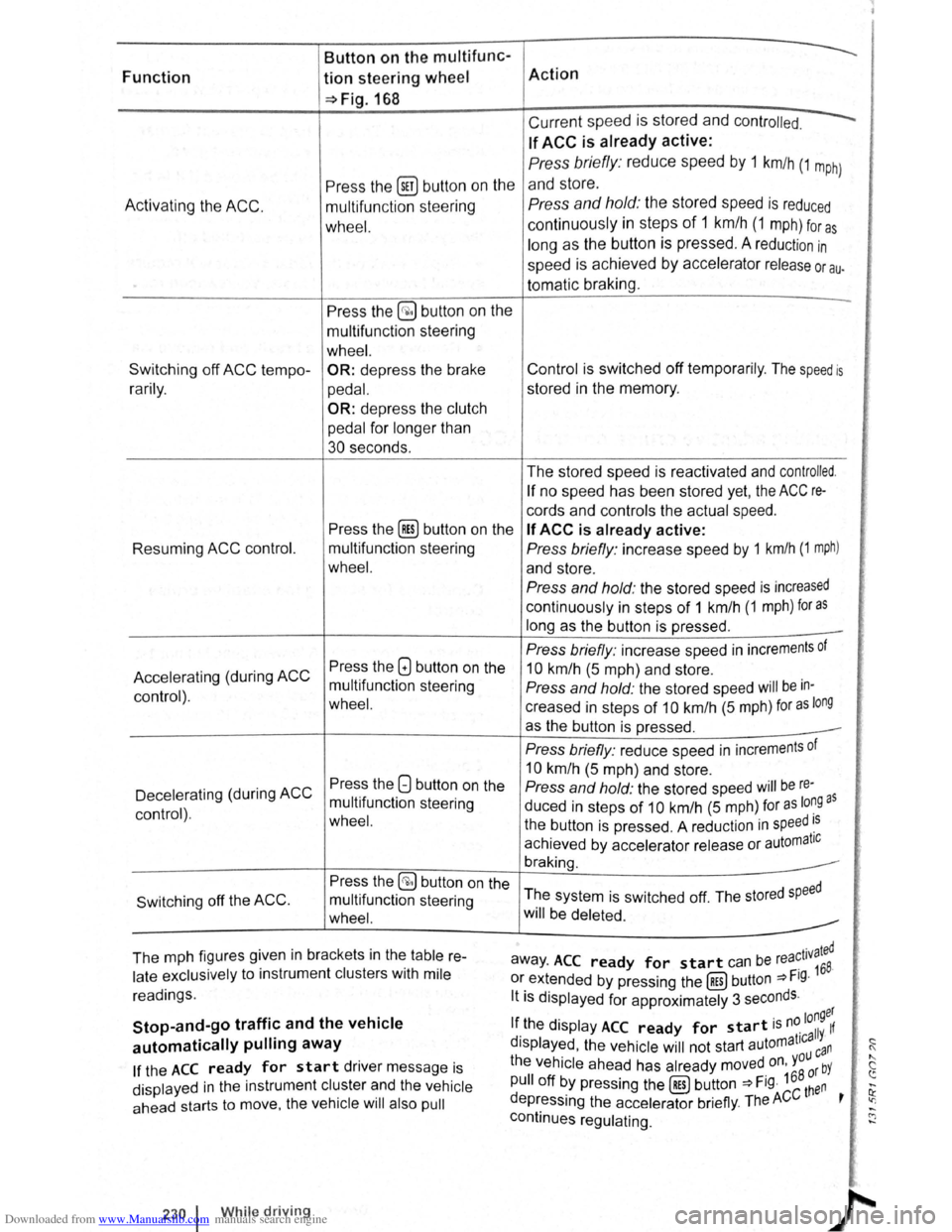
Downloaded from www.Manualslib.com manuals search engine Button on the multifunc-
Function tion steering wheel Action
~Fig.168
Current speed is stored and contr olled.
If ACC is already active:
Press the (ill) butt on on the
Press briefly : reduce speed by 1 km/h (1 m ph)
and store.
A c
tivating the ACC. multifun ction stee ring Press and hold: the stored speed is reduced
wh eel. continuously in steps of 1 km /h (1 m ph) for a s
long as the button is pressed . A reduction in
speed is achieved by accelerator release or au.
tomatic braking.
Press the
§;) button on the -
multifunction stee ring
wheel. .'i
Switching off ACC tempo -OR: depress the brake Control is switched off temporarily . The speed is i:::
r a rily . ped al. stored in the memory. 0
:!
OR: depress the clutch
pedal
for longer than <'
30 seconds.
The stored speed is reactivated and
controlled.
If no speed has been stored yet, the ACC re-tr
cords and controls the actual speed. i)
Press the [Res) button on the If ACC is already active: i!:
Resuming ACC control. multifunction steering Press briefly : increase speed by 1 km/h (1 mph) ~· !'·
wheel. and store . [~
Press and hold: the stored speed is increased
continuously in steps of 1 km /h (1 mph) for as
long as the button is pressed . -
Press briefly: increase speed in increments of
l'•
Press the GJ button on the
Accelerating (during ACC 10 km/h (5 m ph) and store .
mult ifunction steering
Press and hold: the stored speed will be in-
control) .
wheel. creased in steps of 10 km/h (5 mph) for as long
as the button is pressed .
Press briefly: reduce speed in increments of ~i
Press the 8 button on the
10 km/h (5 m ph) and store .
Decelerating (during
ACC Press and hold: the stored speed will be re-)
multifunction steering
duced in steps of 10 km/h (5 m ph) for as lo~Q as control) . wheel. the button is pressed . A reduct ion in speed ~s
achieved by accelerator release or automatiC ~f
braking.
Press the
§;) button on the
The system is switched off. The stored
speed Switching off the ACC . multifunction steering
wheel. will be deleted.
The mph figures given in brackets in the
table re-r ated away . ACC ready for start can be rea~ 1v
168.
late exclusively to instrument clusters with mile or extended by pressing the (RES) button ~Fig. :;
readings. lt is displayed for approximately 3 seconds .
,,
Stop-and-go traffic and the vehicle longer
If the display ACC ready for start is n~ 11 If
automatically pulling away d ' t1ca Y· ~ !Splayed , the vehicle will not start automa ca n (
If the ACC ready for start driver message is the vehicle ahead
has already moved on, you bY " c
pull off by pressing the (RES) button ~Fig. 168 ~~n ~
displayed in the instrument cluster and the vehicle ......
ahead starts to move, the vehicle will also pull depressing the accelerator briefly. The ACC t ' ~ .....
continues regulating. C"J ......
~·
f);
230 1 While drivin g
Page 115 of 138
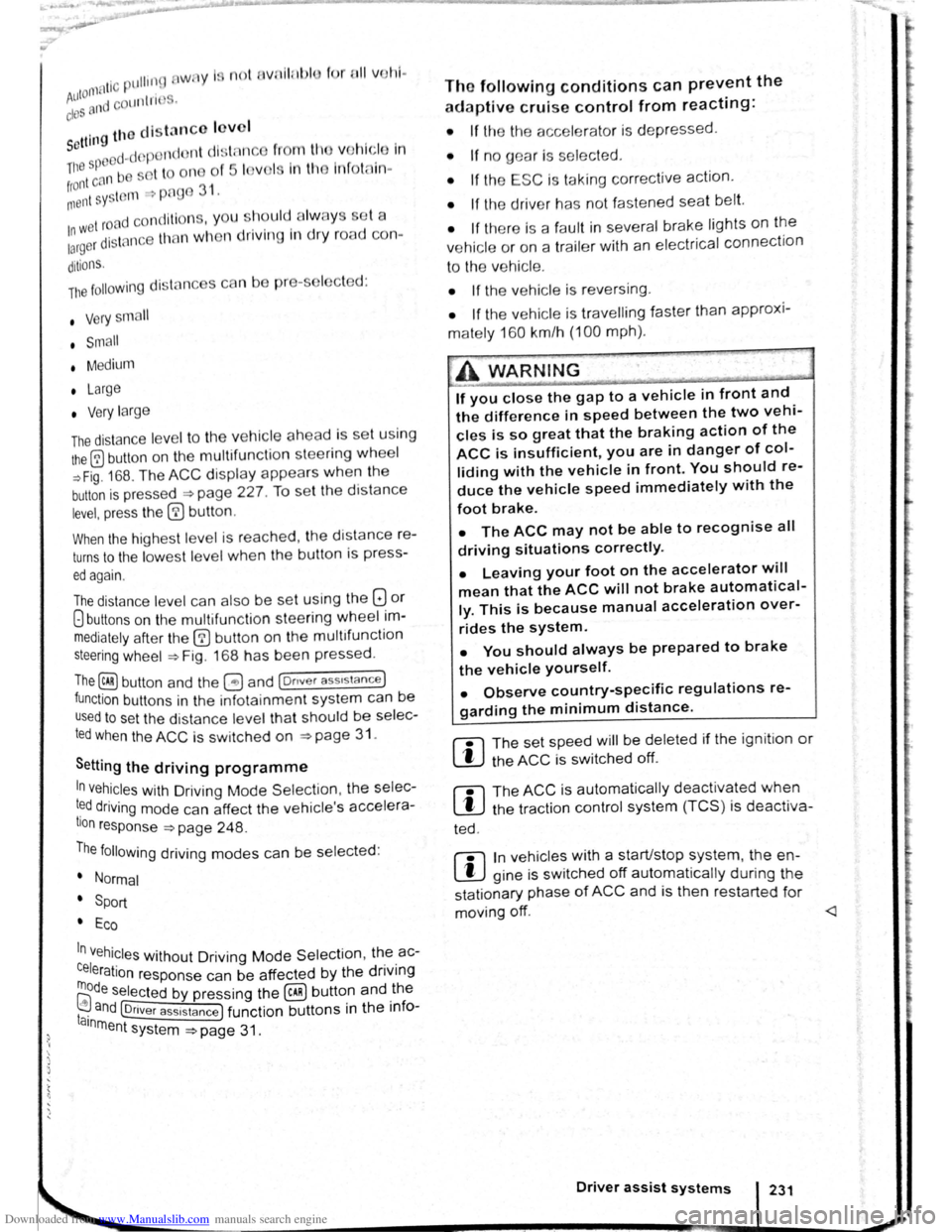
Downloaded from www.Manualslib.com manuals search engine ,,nti pttllinfl W• y I not wnllniJI for tdl vo h l-
fltllOI · and cOtllltJJ(' ciOS ·
. g th o clist::tnco lo vo l sett Ill
P d -d O I nclt nt dl st:1n
lhe s t t o n of 5 I v front can b -
vo hl cl In
lnfot in-
n,ent sy stem ,.-;. Pt g 3 1 .
w et road con d ill n , y u llo uld alw y s s t a
:~rger distn nce lh c n wl 1 n drivl11g In dry road con-
ditions.
lt1e following di sta nc s c n b pre-s I cle d :
• very sm 11
• Small
• Medium
• Large
• V ery large
The dis ta nce le ve l to the ve hi cle ahead is se t u sing
the© button on the multifun ction stee ring wheel
~Fig. 168 . The ACC disp la y appears whe n the
button is pressed ~page 227. To se t th e dis ta nce
level, press the (1) button .
When the hig hes t lev el is reached, the distance re
turns to the low est level when th e butt on is press
ed again.
The distance level can also be set usi ng the Q or
8 buttons on the mult ifun ction stee ring wheel im
mediately after the (1) button on the mult ifunction
steering whee l ~Fig. 168 has been pressed .
The~ button and the G and (Dnver ass1stance )
function buttons in the infotainment system can be
used to set the dista nce level that should be selec
ted when the ACC is sw itched on ~page 31 .
Setting the driving programme
In vehicles with Driving Mode Selection , the selec
t~d driving mode can affect the vehicle 's accelera
tion response ~page 248.
The following driving modes can be selected :
• Normal
• Sport
• Eco
In v h' . e lcles Without Driving Mode Selection , the ac-
Celeration response can be affected by the driving
rnode s I IT.Dl ~a e ected by pressing the ~ butto.n and _ the
I . nd @nver assistance ) function buttons 1n the 1nfoa1nrne t n system ~page 31 .
The following conditions can prevent the
adaptive cruise control from reacting:
• If the the acce le rator is depressed.
• If no g ear is selected .
• If the ESC is taking corre ctive action .
• If the driv er h as no t f astened seat belt.
• If there is a fau lt in seve ral brake lights on the
v e hicle or on a traile r with an electrical
connection
to the vehic le .
• If the vehicle is reve rsing .
• If the vehicle is travelling faster than approxi
mately 160 km/h (100 mph).
A WARNING
If you close the gap to a vehicle in front and
the difference in speed between the two vehi
cles is so great that the braking action of the
ACC is insufficient, you are in danger of col
liding with the vehicle in front. You should re
duce the vehicle speed immediately with the
foot brake.
• The ACC may not be able to recognise all
driving situations correctly.
• Leaving your foot on the accelerator will
mean that the ACC will not brake automatical
ly. This is because manual acceleration over
rides the system.
• You should always be prepared to brake
the vehicle yourself.
• Observe country-specific regulations re
garding the minimum distance.
rn
The set speed will be deleted if the ig nition or
the ACC is switched off.
rn
The ACC is automatically deactivated when
the tract ion control system (T CS ) is deactiva-
ted .
rn
In vehicles with a start/stop system, the e n
g ine is switched off automatical ly during the
stat ionary phase of ACC and is then restarted for
moving off.
Page 117 of 138
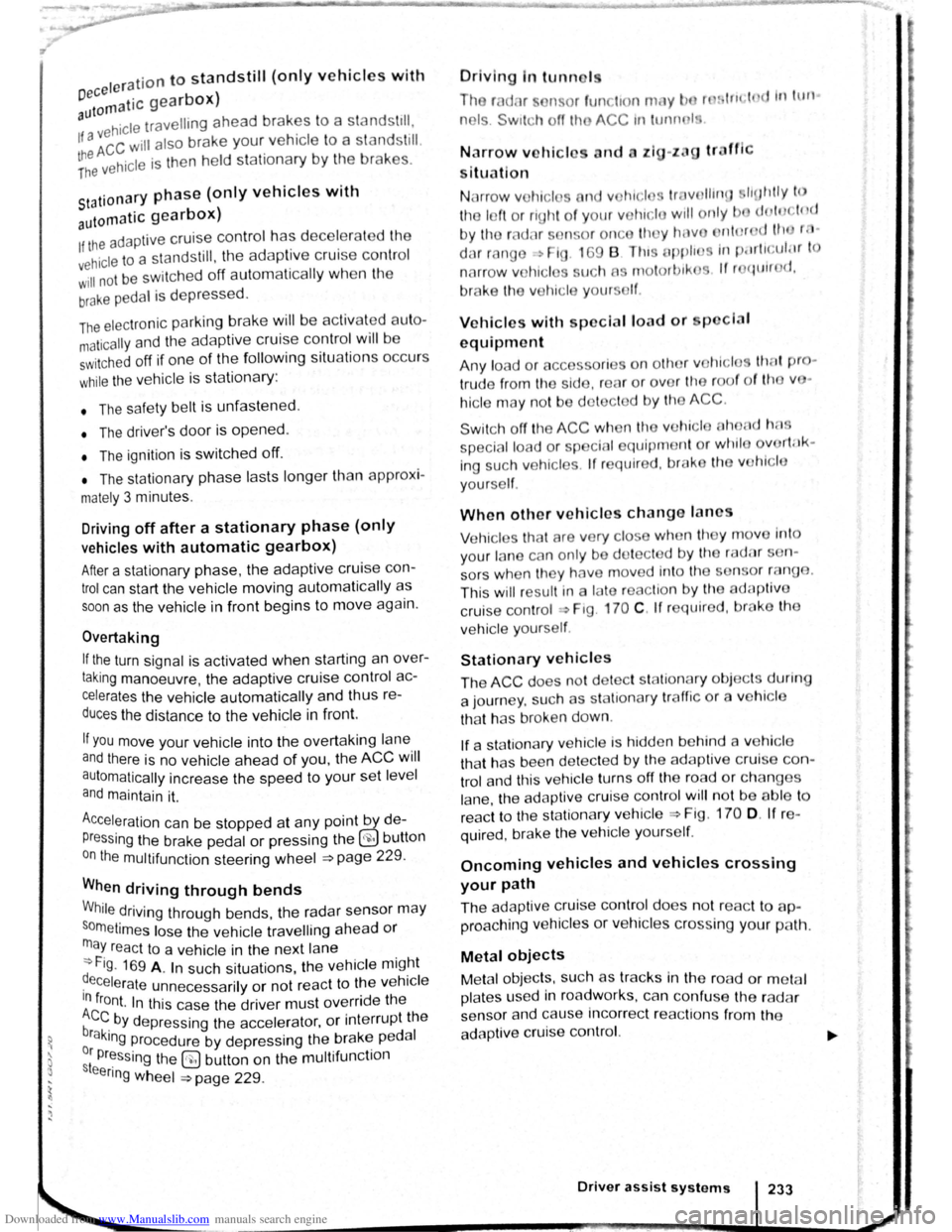
Downloaded from www.Manualslib.com manuals search engine I ation to standstill (only vehicles with pece er )
rnatic gearbox 3uto hicle travelling ahead brakes to a standst1ll ,
If a ;~c will also brake your vehicle to a s tands till.
~:e vehicle is then he ld stationary by th e brakes.
Stationary phase (only vehicles with
autornatic gearbox)
If the adap tive cruise control has decele ra t d the
vehicle to a standstill, the adapt.ive cruise contr o l
will not be switched off automatically wh en the
brake pedal is depressed .
The electronic parking brake will be activated auto4
matically and the adap tive cruise control will be
switched off if one of the following situations occurs
while the vehicle is stationary:
• The safety be lt is unfastened .
• The driver's door is opened.
• The ignition is switched off.
• The stationary phase lasts longer than approxi4
mately 3 minutes .
Driving off after a stationary phase (only
vehicles with automatic gearbox)
After a stationary phase, the adaptive cruise con
trol can start the vehicle moving automatically as
soon as the vehicle in front begins to move again.
Overtaking
If the turn signal is activated when starting an over
taking manoeuvre , the adaptive cruise control ac
celerates the vehicle automatically and thus re
duces the distance to the vehicle in front.
If you move your vehicle into the overtaking lane
and there is no vehicle ahead of you , the ACC will
automatically increase the speed to your set level
and maintain it.
Acceleration can be stopped at any point
by de
Pressing the brake pedal or pressing the @ button
on the multifunction steering wheel ~page 229.
When driving through bends
While dr iving through bends, the radar sensor may
sometimes lose the ve hicle travelling ahead or
rnay r eac t to a ve hicle in the next lane
; Fig. 169 A. In such situations, the vehicle might
.
ecel e rate unnec essarily or not react to the veh icle
In front. In this case the driver must override the
Abcc by depressing the accelerator, or interrupt the rak· lng procedure by depressing the brake peda l
or Pressing the ~ button on the multifunction
ste · ~ enng wh eel ~page 229.
Driving In tunn I
Th rnd~u nso r run .tton mt y lH n slt11.l clln tun ·
n Is. Sw1tch off th ACC m tunn I•
Narrow v e hlcl
situation
nd · zl -z g tr ff c
Vehicles with special load or p cl
equipment
Any load or cc sari th, t pr
trude from tile sld , r r or ov r 111 r o f o f th v •
hicle m y no t be d t et d y th ACC .
Swit ch
off the ACC wh n tt1 v 'hi cl ~h ld h e
special lo d or sp ci I equi pm nt o r whil ov rt ;Jk·
ing such vehic les. If req uir d. brak th v hi I
yourself.
When othe r vehicles change lane
V ehicles that are ve ry close whon th y mov Into
your lane can onl y be do tec t d by th r d. r s n
sors when they h ave moved Into the s nsor r ng
This w ill resul t in a late r action by th dap tiv
cruise control
F1g. 17 0 C. If r quir d , br ke th e
vehicl e your self.
Stationary vehicles
The ACC do es not de tec t st tionary obj cts durin
a journey , such as st tion ary traffic
or a ve hi cl
th at has brok en down .
If a stationary ve hi cle is hidd en behind a ve hi cle
th at h as been detected by
the adap tive cruis e con
trol and this vehic le turns off the road or changes
la ne , the adaptive cruise contr ol will not be ble to
re ac t to the s ta tion ary vehicle Fig.
170 D. If re-
quired, brake the vehic le yourself.
Oncoming vehicles and vehicles crossing
your path
The adap tive cruise contro l does not react to ap
proaching vehicles or v ehicles crossing your p th.
Metal
objects
M eta l objects, such as tracks In the road or m et 1
plates used in roadworks, can confuse the radar
sensor and cause in correc t reactions from the
adap tive cr uise con trol.
..,..
Driver assist systems 233
Page 118 of 138

Downloaded from www.Manualslib.com manuals search engine Possible radar sensor function impairments
The adaptive cruise control will switch off tempora
rily if th e radar sensor function is impaired , e .g .
due to heavy rain, spray , snow, ice or mud . A cor
responding message will appear in the instrument
clu ster display .
Clean the radar sensors as re
quired .
The adaptive cruise control will automatically be
available again as soon as the radar sensors are
no longer impaired . The message in the instrument
cluster display goes out, and the adaptive cruise
control can be reactivated .
~trong. reflected radiation of the radar signal , e.g.
1n mult1-storey car parks , can impair the function of
the radar sensor .
Towing a trailer
The adaptive cruise control operates with reduced
dynamics when the
vehicle is towing a trailer .
Overheated brakes
If the brak~s. overheat , e .g . following heavy braking
or when
dnv1ng down steep inclines for long peri
ods , the
ada~tive cruise control may be deactiva
ted
t~mpor~nly. A correspond ing message will ap
p e ar
.m the tns~rument cluster display. lt is then not
poss1ble to act1vate the adaptive cruise control.
As soon as the temperature of the brakes has de
creased sufficiently , the adaptive cruise control can
be activated again. The message in the instrument
cluster
display goes out. If the message ACC not
ava i 1 ab 1 e does not go out for a long time, there
is a fault. Proceed to a qualified workshop. Volks
wagen recommends using a Volkswagen dealer
ship for this purpose.
.,. . ..,,
... -,
If the message ACC ready for start ap·
pears
in the instrument cluster display and
th_e vehicle in front moves off, your vehicle
w1ll move off automatically. In some cases
the radar
sensor may be unable to detect ob·
st~cles that are located in the vehicle's path.
Th1s can result in serious injury and acci·
dents.
l
• Always check the road ahead before the
veh~cle pulls away. If necessary, cancel the
pulling away procedure by depressing the
brake
pedal.
~--~--------------------~~
Page 119 of 138

Downloaded from www.Manualslib.com manuals search engine ' )
)
Area monito ring system (Front Assist)
QJl Introduction
This ch a pter contains information on the following
s
ubjects:
warning lamps and displays . . . . . . . . . . . . . . 236
Radar sensor ....... · · . . . . . . . . . . . . . . . . . . 237
Operating the area monitoring system (Front
Assist) .... . .. · · · · · · · · · · · · · · · · · · . . . . . . . . 237
Temporarily switch off the area monitoring
system (Front Assist) in the following
s it u
ations . . . . . . . . . . . . . . . . . . . . . . . . . . . . . . 238
System limits . . . . . . . . . . . . . . . . . . . . . . . . . . . 238
C i
ty emergency brake function . . . . . . . . . . . . 239
The area monitoring system (Front Assist) helps to
avoid rear-end collisions.
lt uses a radar sensor to monitor traffic situations
up to a distance of approximately 120 metres in
front of the vehicle within a speed range of approx
i
mately 5 km/h (3 mph) to 210 km/h (130 mph) .
The area monitoring system (Front Assist) can
warn the driver about imminent collisions, pre
pare the vehicle for emergency braking in case
of danger, assist with braking, and initiate auto
matic braking.
Additional
information and warnings:
• Exterior views ~page 6
• Volkswagen information system ~ page 26
• lnfotainment system ~page 31
' Cruise Control System (CCS ) ~page 218
'
Speed limiter ~page 222
' Accessories , modifications , repairs and renewal
o f
Parts ~page 320
Distance warning
If the system detects danger from driving too close
to.the vehicle in front , the system can warn the
~nver by showing a corresponding message in the
~nstrument cluster display ~page 236. The warn
Ing Period varies according to the traffic situation
a
nd the driver's response . Front Assist is not a
sub t · · s ltue for the full concentration of the dnver .
Advance warning
h lfth e system detects a potential collision with a veICI · e .e .1n front, the system can warn the driver by 1111tt1ng an acoustic warning and showing a corre-spond· · PI lng message in the instrument clus~er diS-
ay ~Page 236 . The warning period vanes ac- carding
to the
traffic situation and the driver's re
sponse . Front Assist is not a substitue for the
full
concentration of the driver .
At the
same time it prepares the vehicle for possi
ble emergency braking ~ ~.
Urgent warning
If the driver fails to respond to the advance warn
ing, the system can initiate a quick jolt of the brake
in order to draw the driver's attention to the
in
creasing danger of a collision.
Automatic braking
If the driver also fails to react to the urgent warn
ing, the system can slow the vehicle down auto
matically by gradually increasing the braking force.
The system can help to reduce the consequences
of an accident by reducing the speed at which a
potential collision might take place .
Brake assistance
If Front Assist detects that the driver is not braking
sufficiently when there is a risk
of collision , the sys
tem can increase the braking force and thereby
help to prevent a collision . Brake assistance works
only
for as long as the brake pedal is pressed
hard.
The intelligent technology used in Front As
sist cannot overcome the laws of physics.
The driver is always responsible for braking
in time. If Front Assist issues a warning, im
mediately apply the foot brake to slow the ve
hicle down or avoid the obstacle, depending
on the traffic situation.
• Adapt your speed and distance from the
vehicles ahead to suit visibility, weather, road
and traffic conditions.
• Front Assist cannot prevent accidents and
serious injuries on its own.
• Front Assist can issue unnecessary warn
ings and carry out unwanted braking inter
ventions in certain complex driving situa
tions, e.g . at traffic islands.
~----------------------------_j~
Driver assist systems 235
-
Page 120 of 138

Downloaded from www.Manualslib.com manuals search engine ssis t an Issue unnecessary warn
ut unwanted braking inter-
h n ils f m ti n is impaired, e .g . If
sili " f the radar sensor has been
hil the ehicle is in motion, Front As
t r a t to persons, animals and
r s ing or a proaching in the same
li."f ' ll.'v.
ig. 1 7 1 In t11e instrumen t cluster display: dis
h-m e ammg d1splay
arnin lamp
Lit up , Possible cause :::) ~
r:l Tl1o br ake p dal tr ave l decrcas ~
L!J A ss is t tr iggers til e br ak s. Th, 111 When ~rr
the bmke p dal f el s tiff er. ay ma e
rn
Aut om atic br aking intervention by F . rontA s 1s t can be stopped by depres ing the d~~~
the acce l rator, or throug h a steering interv enh~n
r:l D eac tivate Front Assis t if it doe not fun,
L!J as describ ed in tl1is chapter, e .g . if mu11,~;:
unw ant ed inte rventions occur. Have the s Sttlm
checked by a qualifi ed workshop. Volkswagen rec
ornm ends using a Volk swagen dealer hip for t11s
purpose .
r-fl1 First read and observe the introductory
l-W1 information and safe ty warnings! on
page 235 .
I
Collts ion warning .a) The system detects a
potential
collision with a veh1cle in front
I =:-page 237 .
Solution 1
. . I Depress thtl Brake or take avoiding action I brake pedal.
a) tspla e>d tn colour on an mstrumen t cluster wtth colou r dtspla y.
i tan e warning in the instrument cluster
di play
If tl'e safe d1stance to the veh1cle in front drops be
l the mmimum le el, a distance warning will ap
pear in the instrumen t cluster display ~Fig. 171.
In reas e the distance.
ailure to observe illuminated warning lamps
and displays can cause accidents and seri
us Injuries.
• Never ignore illuminated warning lamps
and displays.
Whtle driving
. ' tne disp!J'
r:l Whe n Fron t As sist is sw1t c h ed or' erWntten
L!J in the instrumen t cluster can be ovg an111·
. 1 f nctio ns. e · by d1splays related to ot 1e r u
coming telephone cal
l.
Page 122 of 138
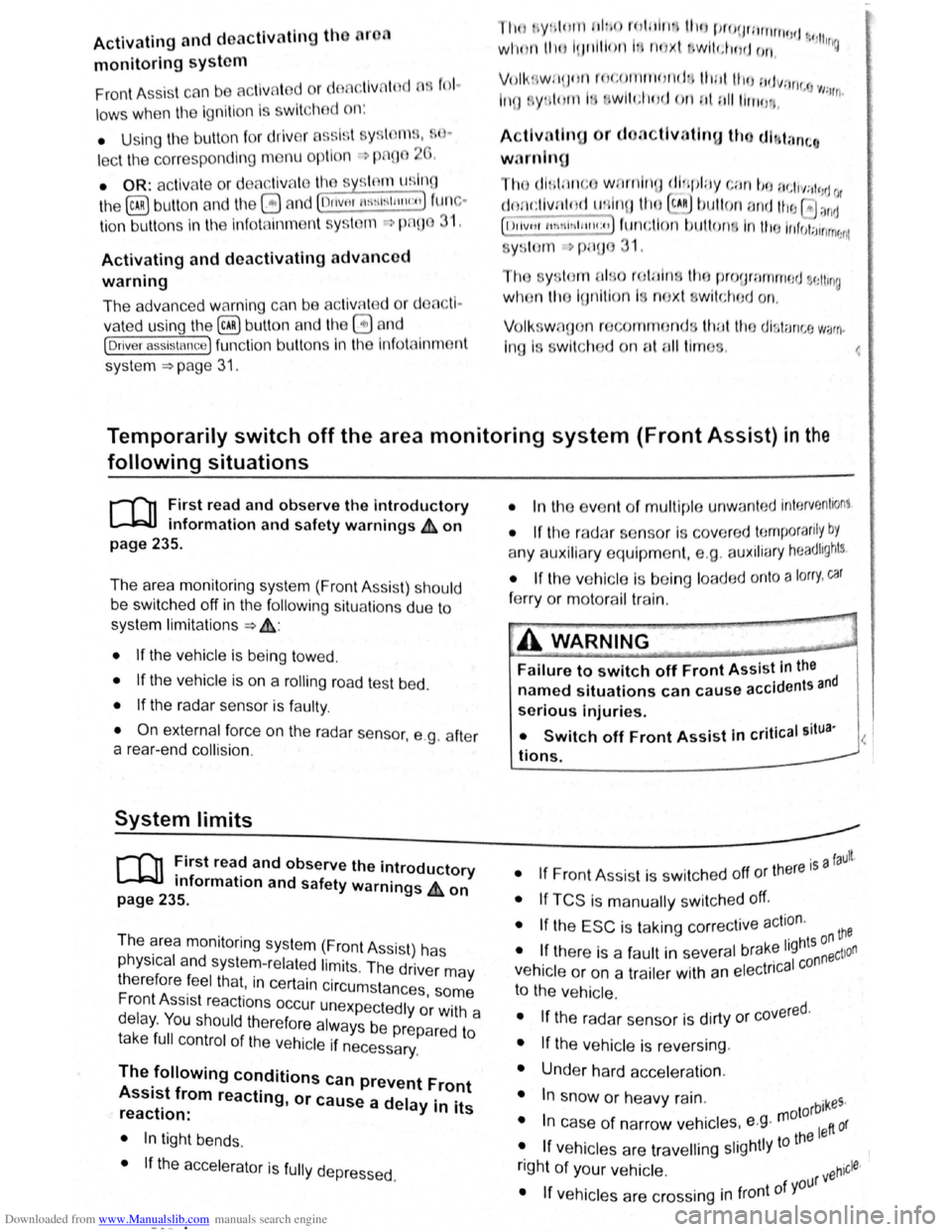
Downloaded from www.Manualslib.com manuals search engine Activating and deactlv ting th ' r ,
monitoring sy stcn1
Front Assis t can be active t d o r ciE, cllv to d L fnl ..
lo w s when th e igniti on Is witcl1 d on :
• U sing the butt on f or drlv r c , sl." l y.._ \c 1n~~, " n ..
lect the corresp o ndin g m nu opti on ~ pr a ·
• OR : activate or d Clctlv ate tho • s tc n1 ll! I no
the (c AR ) button and the G a nd Drlvtll ,:,: l: ' '"''c ., fun , ..
t ion buttons in the
fo la inm nt sy s t( 111 • png 3 1.
Activating and deactivating advanced
warning
The adv a nced w arning ca n be ocllv nto d or dO;"lCti
va te d using the (tAR) butto n and the G and
(Driver a ss istf m ce ) function buttons in the lnf ot._ lnrn Jlll
syst en1 ~pag e 31.
IIHJ y: lrH ll tl: n ru t:iln· lt1n fH J(Jnnr1111,J tl .
I , •,lltw~
wiH 11 tiH lq11ltlnn "' x t wltt,h n d rJt ':f
V n il . w : t(JOfl r fH,Oir IItH HId ttu d tt HJ ; 1dvqw 1 • '
J W·Hrt
In n yt 1t '"I wlt<.IHJd on tl tlllllrw,·,,
A c
tlvntln J or do a tlv atlnu th <.JI itt"tnc;o
w. r u in g
1 ho <11 tn nc< wru nlno (11 pi:Jy c :u1 b o tu ,llv;''' 'd r1r
d< \cllvnl( cl I If lrl(J ttll ( tARj tHJliCJt ' Hlfj lhtJ f "J ~Httj
Q >rlvnt ru1 iJ ,I,.r~e:t, fune11on t) IJlt CHl In U1 irlfCJ!:Jir tt n rsnt
y~torn >pno 3 1.
h l y! torn nit o r lHir H lho proor:srnrnnrJ (,lt1n g
wi H n l11 lunlll or I noxl witch od or,
V olk . w . oon ror,ornrnf nd UHtl Ulo tJI tnrtt,(j W~rrt·
lng 1:1 'w lt c t lO d on Ht oil tlm' ( .
Temporarily switch off the area monitoring system (Front Assist) in the
following situations
r-f'n First read and observe the introductory
L-Wl information and safety warnings £ on
page 235.
The area monitoring system (Front Assist) s h o uld
b e switched off
in the following situations due to
syst em limit
ations ~ £ .:
• If the ve hicl e is being towed.
• If the ve hicl e is on a rolling road test be d .
• If the radar senso r is faulty.
• On exter na l force on the radar sensor, e .g . afte r
a
rea r-end collision . •
In
the ev nt of mu ltip le unwanted intorventioM
• If tt1e ra d or se nso r Is co ve red tornpo rarily by
a ny a uxili nry equipm ent , e.g . a uxiliury headlights.
• If the vehic le i s being loaded onto a lorry, car
f e rry or m oto rail tr ain.
Failure to switch off Front Assist In the
named situations can cause accident s and
serious injuries.
't ' 1 situa· • Switch off Front Assist In en tea <
tions.
System limits ~
---------------------------------------------------
[Q] ~irst rea~ and observe the introductory
anformatton and safety warnings & on
page 235.
The ~rea monitoring system (Front Assist) has
phys1cal and syste~-relate.d limit s. The driv er m ay
there for e feel that, 1n certa m circums tances s
F
t A . t
. , ome
r o n
ssls react ions occur unexpec te dly or with a
de la y. You should the re fore alw ays be prepare d t
take full control of the vehicle if necessar y. 0
The .following conditions can prevent Front
Assast from reacting, or cause a dela . .
reaction: Y 1
" Its
• In tig ht bends .
• If the acce lerato r is fully depressed .
. a fault
• If Front Ass is t i s s wit c h e d off or there 15
• If TCS is m anu ally swit ch ed off .
• If the ESC is ta king corrective action. tne
• If there is a fa ult in se vera l brake lightsnonnectioO
. · al eo vehtcle or on a traile r with an electnc
to the ve hi cle .
• If the ra d ar senso r is dirty or cove red.
• If the vehicle is re ve rsing .
• Under hard acce le ra tion .
• In snow or hea vy ra in . bikeS·
motor
• In case of n a rrow ve hicl es, e.g . left or
• If ve hicl es are tr ave lling slightly to the
right
of y o ur ve hicl e. vehicle·
• If vehic les are crossing in front of your